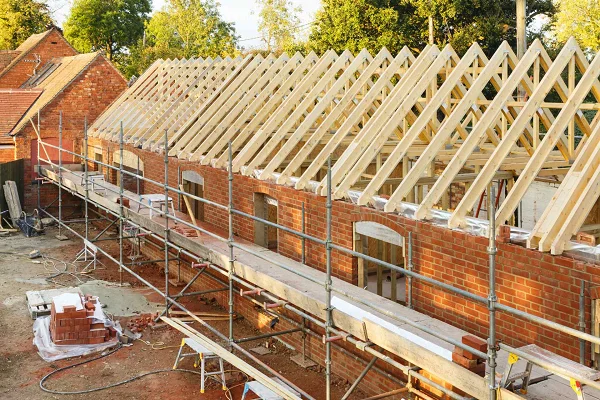What Are The Stages of Development Finance?
What Are The Stages of Development Finance?
Turning your development project from a dream into reality requires careful planning and securing the right funding. This is where development finance comes in, providing the crucial capital needed to navigate the various stages of the development process. But what exactly are these stages, and what can you expect at each step?
1. Enquiry and initial advice:
· Seek professional guidance: Before diving into the specifics, connect with a development finance broker or lender to understand your options and receive initial advice. This stage involves discussing your project overview, budget estimates, and financing needs.
· Free consultations: Many lenders offer free consultations, allowing you to explore your options and ask questions without any initial financial commitment.
2. Application and agreement in principle (AIP):
· Formal application: Once you’ve chosen a potential lender, proceed with a formal application. This typically involves submitting detailed project information, including plans, budgets, and financial statements.
· Agreement in Principle: Based on your application, the lender may issue an Agreement in Principle (AIP). This isn’t a guaranteed loan offer but signifies their initial willingness to lend, subject to further assessment.
3. Due diligence and valuation:
Scrutinising the details: The lender will conduct thorough due diligence, meticulously evaluating your project’s viability. This may involve:
· Site visit: Assessing the development site and surrounding area.
· Valuation: Obtaining professional valuations of the land and the completed development’s potential value.
· Financial checks: Verifying your financial health and ability to repay the loan.
Transparency is key: Providing the lender with all necessary information and maintaining open communication throughout this stage is crucial for a smooth process.
4. Loan offer and legal documentation:
· Formal loan offer: Upon successful due diligence, the lender will present a formal loan offer outlining the loan amount, interest rate, terms, and repayment schedule.
· Legal agreements: Once you accept the offer, lawyers will draft and finalise legal agreements, including the loan agreement and security documents. This stage requires careful review and legal counsel to ensure you understand the terms and implications.
5. Completion and drawdowns:
· Reaching the finish line: Upon completing the legal formalities, the loan becomes finalised, and the first tranche of funds, often used for land purchases, is released.
· Stage payments: Subsequent funds are typically released in stages, called “drawdowns,” based on pre-agreed milestones and the completion of specific project phases. This ensures the funds are used as intended and the project progresses as planned.
6. Repayment and exit strategy:
· Exit plan in sight: Throughout the development process, have a clear exit strategy in mind. This could involve selling the completed property, refinancing the loan with a long-term mortgage, or other options, depending on your project goals.
· Meeting your obligations: Repay the loan according to the agreed-upon terms, ensuring a smooth exit from the development finance phase.
Remember: Each stage of development finance is crucial, and navigating it successfully requires careful planning, clear communication, and professional guidance. By understanding these stages and collaborating with experienced professionals, you can turn your development project into a success story.
Do You Need a Deposit for Development Finance?
Embarking on a development project is an exciting venture, but one of the initial questions that often arises is whether a deposit is required for development finance. In this blog post, we’ll delve into this query, drawing insights from reputable sources such as ukpropertyfinance.co.uk, to shed light on the role of deposits in the realm of development finance.
Traditional mortgage vs. development finance
Traditional mortgages typically require a down payment or deposit, but the landscape changes when it comes to development finance. According to information from ukpropertyfinance.co.uk, the requirements for a deposit can vary based on the type of financing sought. In many cases, development finance lenders focus more on the project’s viability and potential than a hefty upfront deposit.
Flexible financing options
One of the advantages of development finance, as highlighted by ukpropertyfinance.co.uk, is the flexibility it offers in comparison to conventional mortgages. Development finance lenders are often more concerned with the project’s potential and the borrower’s ability to deliver a successful outcome. This can result in a more tailored financing solution that aligns with the specific needs and circumstances of the development project.
Loan-to-cost (LTC) ratios
Developers often encounter loan-to-cost (LTC) ratios when exploring development finance options. This ratio represents the percentage of the project costs that the lender is willing to finance. According to ukpropertyfinance.co.uk, lenders may cover a significant portion of the development costs, reducing the need for a substantial upfront deposit. The LTC ratio is a crucial factor in determining the financial structure of the development finance agreement.
Risk assessment and loan terms
In the world of development finance, risk assessment is a key factor in determining loan terms. Lenders assess the risk associated with the project, the borrower’s track record, and the market conditions. UK Property Finance emphasises that in certain cases, a well-structured and low-risk project may lead to more favourable loan terms, potentially minimising the need for a sizable deposit.
Working with experienced brokers
Navigating the intricacies of development finance can be challenging, especially for those new to the process. Engaging with experienced finance brokers, as recommended by ukpropertyfinance.co.uk, can be instrumental in securing the most favourable terms and conditions. These professionals have insights into the market and can guide developers through the nuances of development finance, helping them understand deposit requirements and potential alternatives.
In conclusion
In the realm of development finance, the need for a deposit is not always a strict prerequisite. As illuminated by insights from us here at ukpropertyfinance.co.uk, the emphasis often lies on the project’s viability, the borrower’s capability, and the overall risk assessment. Developers exploring financing options for their projects should consider the flexibility and tailored solutions offered by development finance lenders, recognising that the landscape may differ from traditional mortgage requirements. Collaborating with experienced brokers can further streamline the process, ensuring developers make informed decisions that pave the way for successful and financially sound development projects.
What Are The Benefits of Development Finance?
In the dynamic landscape of the United Kingdom, development finance plays a pivotal role in driving progress and overcoming the hurdles of economic growth. Among the various instruments available, bridging loans have emerged as a powerful tool to fuel development projects. In this blog post, we will explore the benefits of development finance, focusing on how bridging loans contribute to infrastructure, innovation, and economic prosperity. Additionally, we’ll delve into the significance of a development finance calculator in streamlining the financial aspects of these projects.
Swift capital injection
Bridging loans, a common form of development finance, provide a rapid and flexible source of capital. Unlike traditional lending avenues, bridging loans offer quick approval processes, enabling developers to seize time-sensitive opportunities. This swift capital injection is invaluable for ensuring that development projects can progress without unnecessary delays.
Property development and renovation
Development finance, often facilitated by bridging loans, is instrumental in supporting property development and renovation initiatives across the UK. Whether it’s transforming an old building into modern apartments or revitalising commercial spaces, bridge loans provide the necessary funds to turn visionary projects into reality. This benefits both developers and the communities that stand to gain from improved infrastructure and enhanced living spaces.
Mitigating gaps in funding
Development projects often encounter gaps in funding at various stages. Bridging loans act as a bridge (hence the name) to cover these financial gaps, ensuring that projects can proceed seamlessly. This flexibility is particularly crucial when awaiting long-term financing or navigating unforeseen challenges that might disrupt the project’s financial flow.
Facilitating small and medium-sized enterprises (SMEs)
Small and medium-sized enterprises (SMEs) form the backbone of the UK economy. Bridging loans, as a form of development finance, empower SMEs to undertake ambitious projects, expand operations, and contribute significantly to economic growth. The accessibility of funds allows these enterprises to compete on a larger scale and foster job creation.
Development finance calculator: a strategic tool
A development finance calculator is a valuable tool that aids developers in making informed financial decisions. By inputting project details such as loan amount, interest rates, and repayment terms, developers can assess the financial viability of their projects. This tool helps in planning and budgeting, ensuring that developers have a clear understanding of the financial implications of their chosen development finance route.
The development finance calculator streamlines the decision-making process, offering insights into potential returns on investment and allowing developers to optimise their financial strategies. In a landscape where precision and foresight are crucial, this tool empowers developers to navigate the complexities of development finance with confidence.
In conclusion, development finance, facilitated by bridging loans, is a catalyst for growth and progress in the UK. From property development to supporting SMEs, the benefits are extensive. The strategic use of a development finance calculator further enhances the efficacy of these financial tools, allowing developers to navigate their projects with a clear financial roadmap. As the UK continues to evolve, development finance remains a cornerstone for building a prosperous and resilient future.
What is Meant by Development Finance?
The term “development finance” holds a crucial place in the finance sector. But what exactly is meant by development finance? In this blog post, we’ll unravel the intricacies of development finance, exploring its meaning and purpose and how it plays a pivotal role in bringing ambitious projects to life.
Defining development finance
Development finance is a specialised form of funding designed to facilitate the construction, renovation, or expansion of real estate projects. Unlike traditional mortgages or standard loans, which are typically used for property purchases, development finance is tailored to support the entire life cycle of a development project.
Key features of development finance
Project-Centric Approach
Development finance focuses on the specific needs of a development project, taking into account the costs associated with land acquisition, construction, and other development-related expenses.
It’s a bespoke financial solution that recognises the unique challenges and timelines of property development.
Risk Mitigation
Development projects inherently carry risks, ranging from construction delays to market fluctuations. Development finance is structured to mitigate these risks by providing flexibility and accommodating unforeseen challenges during the project’s lifecycle.
Structured Drawdowns
Unlike a lump-sum payment, development finance often involves structured drawdowns. Funds are released in stages, corresponding to different phases of the project, ensuring that capital is allocated efficiently and tied to project milestones.
Security and Collateral
Lenders offering development finance typically secure the loan against the property being developed. The value of the property and the feasibility of the project are crucial considerations for lenders when assessing the loan.
Tailored Repayment Plans
Repayment plans for development finance are often customised to align with the project’s timeline and cash flow. This could involve interest-only payments during the construction phase, with the principal repaid upon project completion or through the sale or refinancing of the developed property.
Professional Oversight
Lenders offering development finance often work closely with experienced professionals, including surveyors and project managers, to monitor the progress of the development. This ensures that the funds are used efficiently and in line with the project plan.
Development finance serves as a cornerstone for turning ambitious visions into tangible structures. It is a financial instrument that recognises the unique demands of property development, providing a tailored solution to address the challenges and complexities inherent in these projects.
As you delve into the world of property development, understanding the nuances of development finance becomes paramount. Whether you’re a seasoned developer or embarking on your first project, working with reputable lenders and financial experts can help you navigate the landscape of development finance, unlocking the potential to shape the future, brick by brick.
How Does Development Finance Work?
Embarking on a property development project is an exciting journey, but it often requires substantial financial backing to turn visions into reality. Development finance stands as a crucial pillar in this process, offering a specialised funding solution tailored to the unique needs of development projects. In this blog post, we’ll dissect the question, “How does development finance work?” to provide a comprehensive understanding of the mechanisms behind this essential aspect of property development.
Understanding the basics:
Project assessment
Development finance begins with a thorough assessment of the proposed project. Lenders evaluate factors such as the project’s feasibility, market demand, location, and the borrower’s experience in property development.
Loan Structuring
Once a project is deemed viable, the lender structures the loan to meet the specific needs of the development. This includes determining the loan amount, interest rates, repayment terms, and any conditions tied to the release of funds.
Security and collateral
Development finance is typically secured against the property being developed. The value of the property and the potential profitability of the completed project are crucial considerations for the lender.
Structured drawdowns
Unlike traditional loans, development finance often involves structured drawdowns. Funds are released in stages, corresponding to different phases of the project. This ensures that the capital is utilised efficiently and tied to project milestones.
Professional oversight
Lenders often engage professionals, such as surveyors and project managers, to oversee the development. Regular inspections and progress reports help ensure that the project is on track and aligns with the proposed timeline.
Interest-only payments
During the construction phase, developers often make interest-only payments. This alleviates the financial burden during the project’s early stages, when the property is not generating income.
Exit strategy
Development finance is structured with a clear exit strategy in mind. This could involve selling the completed project, refinancing with a traditional mortgage, or another method agreed upon by the borrower and lender.
Risk mitigation
Development projects inherently carry risks, from construction delays to market fluctuations. Development finance is designed to mitigate these risks by providing flexibility and accommodating unforeseen challenges during the project’s lifecycle.
In conclusion
In essence, development finance is a strategic partnership between the borrower and the lender, with the common goal of bringing a development project to fruition. The intricacies of this financial tool ensure that funds are allocated efficiently, risks are managed, and the development progresses smoothly from inception to completion.
As you navigate the realm of property development, understanding how development finance works becomes paramount. Collaborating with reputable lenders, seeking professional advice, and having a clear vision of your project are key steps towards leveraging development finance to turn your real estate aspirations into tangible, thriving developments.
The History of Using Bridging Loans for Development Finance in the UK
The tale is not only about big ideas and governmental policies when it comes to fostering economic growth and propelling real estate development in the United Kingdom. The financial instruments that were essential in making these large-scale initiatives a reality are also part of the discussion. Bridging loans is one such instrument that has significantly altered the landscape of development financing.
The idea behind a bridging loan is straightforward yet tremendously powerful. It’s a form of short-term financing used to fill the space between two significant financial transactions, generally the acquisition of a new property and the sale of an existing one. In the field of development, where timing is frequently the difference between embracing a potential opportunity and missing out, this financial bridge has proven to be of immeasurable value.
Bridging loans were first used for development finance during the 1980s real estate boom in the United Kingdom. As the property market expanded, developers and investors faced the same problem: they needed funds to buy new homes while waiting for their old ones to sell. Traditional lenders were sometimes slow to respond to these requirements, leaving a gap that needed to be filled. The bridging loan found its place in this gap.
Bridging loans gained prominence as a flexible and fast solution for property developers and investors who were looking to capitalise on the booming real estate market. These loans provided the financial flexibility needed to move quickly, make timely offers, and secure properties before other buyers could swoop in. This advantage proved critical in a competitive market where opportunities could vanish in the blink of an eye.
Over the years, the use of bridging loans for development finance has continued to evolve. The financial industry has become more sophisticated, with specialised lenders offering tailored bridging solutions for various development scenarios. From residential projects to commercial ventures, bridging loans have become a reliable tool for funding development initiatives across the UK.
Additionally, the successes made possible by bridging loans have strengthened their standing in the field of development financing. Along with assisting individual investors and developers, they have also helped the real estate industry as a whole thrive, generating employment and bolstering regional economies.
In recent years, as the UK has navigated through economic ups and downs, market uncertainty, and the difficulties brought on by unanticipated occurrences, the significance of bridging loans in development finance has become even clearer. Bridging loans has become a lifeline for people trying to take advantage of possibilities despite the constantly shifting environment due to their flexibility and accessibility.
Looking ahead, the experience of involving bridging loans for development finance in the United Kingdom demonstrates resilience, adaptation, and the capacity for financial innovation. It’s a story that highlights the critical role that these loans have played in shaping the development landscape, and as new opportunities and challenges emerge, it’s safe to say that the bridging loan will remain a valuable asset in the toolkit of those driving growth and progress across the country.
Should Property Developers Hire Agents to Find the Best Deals?
One of the first things you learn when you become a property developer is the importance of being at the front of the queue for prime plots or pieces of land. After all, this represents the very foundation of becoming a successful property developer: beating others to the punch where high-potential build units are concerned.
What’s discovered quickly by newcomers to property developments is that there are countless different options available for tracking down land and properties. You can view listings, head to specialist auctions, speak with commercial state agents, and so on. Play your cards right, and with a little luck (i.e., the right place at the right time) thrown into the mix, you could score yourself something seriously profitable.
But when it comes to the best of the sources available, opinions differ from one developer to the next. Many professionals within the sector (established and aspiring) have chosen to go with the ‘armchair’ approach and to put their faith in web portals.
There is no shortage of online resources for developers in search of profitable investment opportunities, and browsing online opens the door to a full nationwide search at the touch of a button. You can even check out what the UK’s major auction houses are planning to put under the hammer and get a head start on your due diligence.
Best of all, you can add your name to a mailing list, set a bunch of preferences, and be alerted each time something pops up that might be of interest to you, all with no effort required on your part.
All is well and good, but there is a flaw to what seems like a wholly logical approach to seeking development opportunities: the fact that there are probably several thousand more developers just like you who have adopted the exact same approach. The army of armchair-dwelling developers who wait for good investment opportunities to fall (literally) into their laps is growing all the time, creating ferocious competition for those who adopt this approach.
Missing out on the best deals?
Even if you are happy to contend with this kind of competition, there is another huge issue with this particular approach. If there is one important lesson to learn about property developments, it is this:
Some (if not most) of the most lucrative deals available are never listed or marketed online.
The best deals of all have a tendency to be completely ‘off-market’ in nature, meaning you will never even catch sight of them by staying glued to your computer. It is not that these plots and properties are not put up for sale or that numerous potential buyers may find themselves bidding against one another to seal the deal.
Instead, it is simply a case of established commercial estate agents being right at the front of the queue, when and where the most enticing deals pop up. The owner of the property or plot being sold puts together a description of what is on offer; they send this to the commercial agents on their mailing lists, and these agents immediately contact the clients on their own books who are looking for these types of investment opportunities.
In doing so, sellers shift their lots with little to no fuss and get the best possible price for them without ever having listed them on the open market.
Of course, all the above only holds any real value if the agents a property developer hires have the right contacts in the first place. Even so, it illustrates how even the most committed approach to ‘armchair’ research as a property developer could still leave you right at the back of the queue.
Small-Scale Property Development FAQs: Key Questions Answered
-
- What qualifies as a ‘small-scale’ development?
The designation ‘small-scale’ in relation to property developments does not actually have a clear or formal definition. Even so, most regard a small-scale development as one that is made up of around 5 to 20 units (such as flats), capable of generating a profit of say £100k to £500k over a period of 18–to 24 months.
- Are small-scale development projects comparatively simple?
Compared to large-scale development projects, the answer is yes. Small-scale developments tend to be less complex and labour-intensive. But when compared to a standard flip or refurb, even a small-scale property development project can be a much more extensive undertaking. Costs are significantly higher and the scope of the work is greater, calling for the involvement of a knowledgeable and experienced project manager.
- What are the most profitable small-scale development projects right now?
It depends entirely on your knowledge, experience, expertise, budget, and location. Even so, conversion projects (where existing properties are repurposed) tend to be the preferred option for new and aspiring developers. Across the UK, there is a huge and growing contingency of abandoned and unused commercial buildings with enormous potential for residential conversions, many of which have the potential to be exceptionally lucrative.
- Are first-time developers inherently at a disadvantage?
Yes, at least when it comes to funding their first property development project. This is due to the fact that many specialist development finance products are issued exclusively to experienced developers with an established track record. Many lenders exclude first-time developers from consideration, reducing the number of viable funding options available. Even so, it is perfectly possible to fund almost any type of small-scale development project with a bridging loan, a secured commercial loan, or any other viable commercial mortgage.
- How difficult is it for new developers to qualify for funding?
Newcomers to property developments looking to get their first projects on the ground are strongly recommended to seek independent broker support at an early stage. An experienced broker can help pair your requirements with an appropriate lender while at the same time negotiating on your behalf to ensure you get an unbeatable deal. In addition, your broker will help you prepare a strong and convincing application, increasing your likelihood of qualifying for the funding you need.
- Is it not cheaper to apply for funding directly with a lender?
No, and for two important reasons. Firstly, brokers know exactly how to negotiate the kinds of deals that would not be accessible directly from any lender. They also have established relationships with lenders that can lead to significantly reduced borrowing costs and lower fees. In addition, many development finance specialists offer their services exclusively via broker introductions. This means that many of the best deals on the market may be completely inaccessible if you do not apply with the help and support of a broker.
- How are development finance loans issued and repaid?
Specialist development finance differs from bridging loans and other commercial mortgages in that the funds are transferred in a series of instalments. The release of each instalment is tied to the completion of a specific phase of the project, overseen by a surveyor (hired by the bank and paid for by the borrower). Most development finance loans are designed to be repaid within 6 to 24 months, during which interest accrues on a monthly basis. The full balance is either repaid upon the sale of the completed development or by transitioning the loan to a longer-term repayment facility (like a buy-to-let mortgage).







